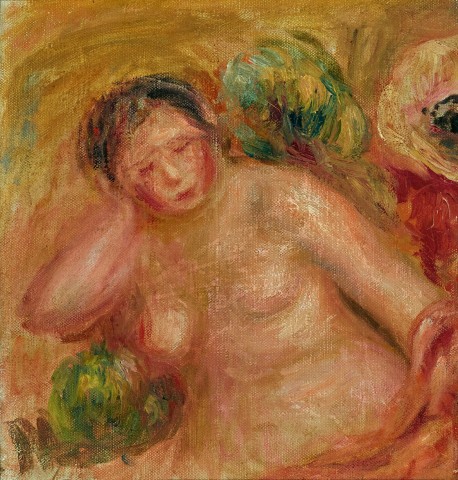FEMME NUE ASSISE, c.1916-17
PIERRE-AUGUSTE RENOIR
oil on canvas
24.0 x 22.5 cm
accompanied by a certificate from the Wildenstein Institute, Paris, dated 17 October 2003, ref. 03.10.17 / 9010
Property from a London estate until 2003
Christie's, London, 11 September 2003, lot 12
Private collection, Queensland
Deutscher~Menzies, Brisbane, 22 February 2006, lot 23
Private collection, Brisbane
Vollard, A., Tableaux, pastels et dessins de Pierre Auguste Renoir, Paris, 1989, p. 76, cat. 304 (illus.)
This work will be included in the catalogue critique being prepared by the Wildenstein Institute from the Francois Daulte, Durand-Ruel, Venturi, Vollard and Wildenstein Archive.
By the early 1910s, Pierre-Auguste Renoir was unanimously acclaimed, financially secure and had been appointed Officier of the Legion of Honour. He was also starting his last cycle of visionary paintings, which culminated in the large Les baigneuses (The bathers), 1918-1919, now in the collection of the Musée d’Orsay, Paris; and to which Femme nue assise, c.1916-1917, is associated. Renoir’s health, however, was ruinous, confined to a wheelchair due to crippling rheumatoid arthritis, his painting hand reduced to a gnarled claw where ‘between his first finger and thumb ... a brush was stuck after the manner of a pen.’1 In spite of this, and with the support of paid assistants, he continued painting (and sculpting) prodigiously. In 1916, his long-time colleague Claude Monet wrote: ‘As for Renoir, he is still amazing. He is said to be seriously ill, and suddenly one hears that he is working and forcing himself, in spite of everything, to continue his work. He is simply wonderful.’2 Picasso called him the ‘Pope of Painting’; Cezanne and Matisse were also admirers of his work.
Femme nue assise was painted at Renoir’s home in Cagnes-sur-Mer on the French Riviera. His practice was to use unstretched canvas ‘tacked onto boards or to strips of wood put together into frames. Like Bonnard, Renoir decided on the final format of the work only after it was completed, readjusting it at the very end.’3 The model here is most likely Andrée Heuschling, known as Dédée, a vivacious, red-haired fifteen year-old who met Renoir in 1915, and would later marry his son Jean. Not only was she ‘gay, and cast over my father the revivifying spell of her joyous youth ... her skin ‘took the light’ better than any model that (he) had ever had in his life.’4 Renoir was indebted to Rococo artists such as Boucher, but also took cues from Mannerism, particularly the distortion figures as a means of heightening emotion or effect. In this manner, Dédée has been rendered plumper than she actually was, which for the artist, was symbolic of the sensual pleasure in life that she imparted.
The female nude in a landscape was a continuous, compelling subject for Renoir and he returned to to the theme in several small canvases made during these last years of his life. In Femme nue assise, Dédée sits in an indeterminate space surrounded by fragments of vegetation and flowers, the whole scene rendered in vigorous brushwork and colour. Renoir sought to depict her as ‘simply one with the landscape ... (but) the most important thing is for it to remain (a) painting.’5 In this regard, the artist’s technique remains visible in Femme nue Assise. After first sketching in the image, Renoir applied layers of thinned turpentine with varying additions of white. ‘After a few more touches, one saw the beautiful round figures emerge from the coloured fog of the first stage of the picture.’6 Dédée, a similarly beautiful round figure, has thus been immersed within her environment by these means, her eyes closed in repose, her body rich with life, all imbued with Renoir’s painterly vision.
1. Georges Besson, quoted in: Florisoone, M., Renoir, Wiliam Heineman, London, 1938, p.29
2. Claude Monet to Georges Durand-Ruel, correspondence, 1916, quoted in: Adriani, G., Renoir, Yale University Press, Connecticut, 1996, p.308
3. Benjamin, R. and others, Renoir in the 20th Century, Los Angeles County Museum of Art, USA, 2010, p.328
4. Renoir, J., Renoir, my Father, Collins and Little, London, 1962, pp.398-399. Dédée appeared in numerous paintings from these years, and was one of the two principal models for Les Baigneuses.
5. Renoir to Albert Andre, quoted in: Roger Benjamin and others, Ibid., p.320
6. Albert Andre, quoted in: Florisoone, M., Renoir, Wiliam Heineman, London, 1938, p.28
ANDREW GAYNOR
